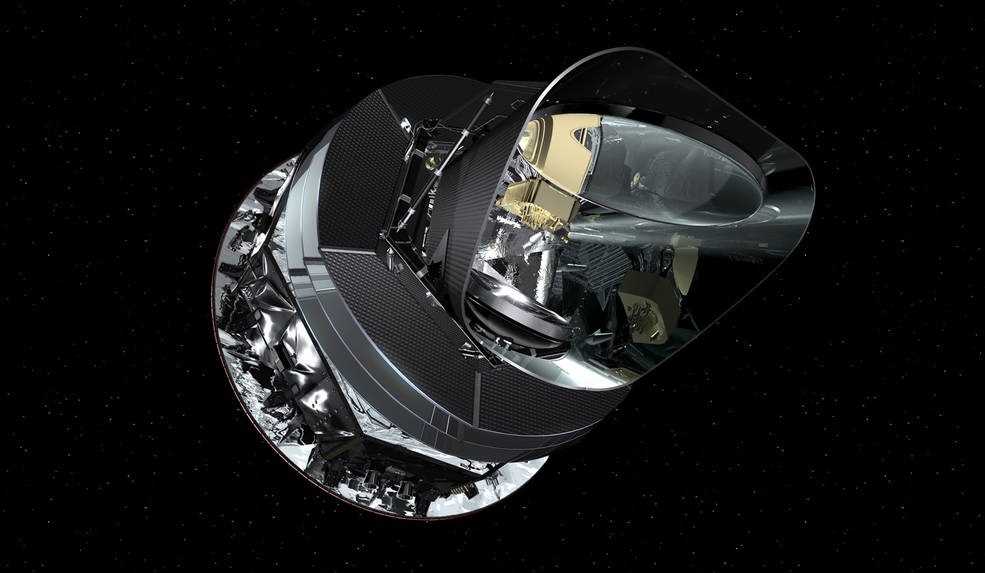[/caption]
After two and a half years of observing the Cosmic Microwave Background, the ESA Planck spacecraft's High Frequency Instrument ran out of its on-board coolant gases over this past weekend, reaching the end of its very successful mission. But that doesn't mean the end for Planck observations. The Low Frequency Instrument, which does not need to be super-cold (but is still at a bone-chilling -255 C), will continue taking data.
"The Low Frequency Instrument will now continue operating for another year," said Richard Davis, of the University of Manchester in the UK. "During that time it will provide unprecedented sensitivity at the lower frequencies."
From its location at the Earth/Sun's L2 Lagrangian point, Planck was designed to 'see' the microwaves from the CMB and detects them by measuring temperature. The expansion of the Universe means that the CMB is brightest when seen in microwave light, with wavelengths between 100 and 10,000 times longer than visible light. To measure such long wavelengths Planck's detectors have to be cooled to very low temperatures. The colder the spacecraft, the lower the temperatures the spacecraft can detect.
The High Frequency Instrument (HFI) was cooled to as close to 2.7K (about –270°C, near absolute zero) as possible.
Planck worked perfectly for 30 months, about twice the span originally required, and completed five full-sky surveys with both instruments.
"Planck has been a wonderful mission; spacecraft and instruments have been performing outstandingly well, creating a treasure trove of scientific data for us to work with," said Jan Tauber, ESA's Planck Project Scientist.
While it was the combination of both instruments that made Planck so powerful, there is still work for the LFI to do.
[caption id="attachment_90007" align="aligncenter" width="580" caption="Now and Then. This single all-sky image simultaneously captured two snapshots that straddle virtually the entire 13.7 billion year history of the universe. One of them is 'now' – our galaxy and its structures seen as they are over the most recent tens of thousands of years (the thin strip extending across the image is the edge-on plane of our galaxy – the Milky Way). The other is 'then' – the red afterglow of the Big Bang seen as it was just 380,000 years after the Big Bang (top and bottom of image). The time between these two snapshots therefore covers about 99.997% of the 13.7 billion year age of the universe. The image was obtained by the Planck spacecraft. Credit: ESA"]
[/caption]
The scientists involved in Planck have been busy understanding and analyzing the data since Planck launched in May 2009. Initial results from Planck were announced last year, and with Planck data, scientists have created a map of the CMB identifying which bits of the map are showing light from the early Universe, and which parts are due to much closer objects, such as gas and dust in our galaxy, or light from other galaxies. The scientists have also produced a catalog of galaxy clusters in the distant Universe -- many of which had not been seen before -- and included some gigantic 'superclusters,' which are probably merging clusters.
The scientists expect to release data about star formation later next month, and reveal cosmological findings from the Big Bang and the very early Universe in 2013.
"The fact that Planck has worked so perfectly means that we have an incredible amount of data," said George Efstathiou, a Planck Survey Scientist from the University of Cambridge. "Analyzing it takes very high-performance computers, sophisticated software, and several years of careful study to ensure that the results are correct."
Source:
ESA
,
UK Space Agency
 Universe Today
Universe Today
